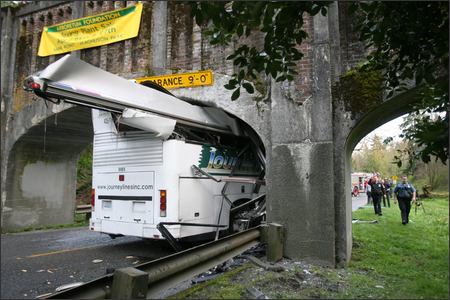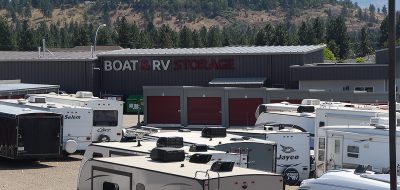 Another view from Lug_Nut. So you have GPS navigation in your RV, it should be smooth sailing now. Well, maybe not quite. There are issues that can be experienced when using many of the makes and models with an RV or any larger than a normal size vehicle. Additionally, there are the odd quirks inherent in many, if not all, GPS makes out there. We can’t do much about these, but we can better manage the GPS RV application.
Another view from Lug_Nut. So you have GPS navigation in your RV, it should be smooth sailing now. Well, maybe not quite. There are issues that can be experienced when using many of the makes and models with an RV or any larger than a normal size vehicle. Additionally, there are the odd quirks inherent in many, if not all, GPS makes out there. We can’t do much about these, but we can better manage the GPS RV application.
The sizes and configuration of some RV’s can make negotiating some roads, turns and geographic conditions, difficult, or in some cases, impossible. The GPS programs are basically made for navigational guidance for general use. Many do not take into account such things as bridge clearance, narrow roads with tight turning radius, grade steepness or other overhead hazards. The upper photo shows a bus that the bus company says was routed by a GPS through a low clearance overpass.
So, how can an RV owner deal better with these challenges? First, the GPS should be user configured to best meet this unique application. Configuration usually includes such things as enabling or disabling interstate highways, toll ways, secondary roads, fastest routes, shortest routes, etc. Generally, choices like “Shortest Route” can lead to less than ideal roadways, at least for larger vehicles. There are some makes that allow you to select your vehicle type, motorcycle, car, truck or bus. These are far more adaptable to larger RV types. Additionally, once a destination has been selected, a choice of route is usually available. This is a good time to study which of the selections would probably take more favorable roads for your rig’s size and type. (Caution: Even pre-programming of a specific vehicle type may not avoid all low clearances. Therefore careful observation of all overpass’s is required as well as common sense.)
Okay, we have programmed the configuration of our GPS, we have also selected the best choice of the offered routes, now what? Well, you have to add one more thing, some common sense. The GPS does not have eyes, and even if it did, it would not necessarily foresee clearance or maneuvering issues that may lay in you path. Let’s look at some of those issues and how to possibly deal with them.
 Low Bridge Clearance: There are over 5,000 accidents each year involving tall vehicles and low clearance bridges at a damage cost exceeding $100 million. You first must be aware of the height of your rig in both feet and meters. It is surprising how many RV owners are totally unaware of exactly what their vehicle’s overhead clearance is.
Low Bridge Clearance: There are over 5,000 accidents each year involving tall vehicles and low clearance bridges at a damage cost exceeding $100 million. You first must be aware of the height of your rig in both feet and meters. It is surprising how many RV owners are totally unaware of exactly what their vehicle’s overhead clearance is.
Possible Solutions: If you are not already, make yourself aware of the statutory clearance for your state or area. This is the minimum height that must be displayed for each structure that is at or below this number. These heights range from 13’6” to about 14’ with the most common being the former. Software is available for some GPS units to add bridge clearance guidance. Additionally, there are other published material listings available both in book form and on the internet such as shown here.
Narrow Roads With Tight Turns: These can be encountered in urban areas or in the boonies. More typically, your GPS, while guiding you through a downtown district, may select a ninety degree right turn. These turns might well be easy in an automobile, but may be difficult or impossible depending on the size and type of RV you have. Yet still, you will hear the unshaken commanding voice, “Right Turn Ahead”.
Possible Tight Right Solutions: Turning in tight downtown areas can better be accomplished if all your turns are to the left. This allows you to nearly complete the turn before even entering the selected street. So, instead of following the GPS guidance direction “Right At The Next Turn” go straight an extra block and turn left. Providing the roads are passable and not one-way, at you, two more left turns will bring you back to your original right turn intersection, but this time you go straight. Your GPS will recalculate your route, so don’t think it’s going to be angry at you and never speak to you again. So, if faced with a turn that you have question that you may not be able to make, don’t do it. Just because “Nagging Nelly” commands a turn, does not make it necessarily the right move. Using common sense here can avoid embarrassment, stress and possible property damage.
Unusually Steep Road Grades: There are streets and roads in North America that you would not want to scale or descend with many RV types. Roads like Canton Avenue in Pittsburg, for example, at a maximum of 37% grade is one of the roads that should be avoided. I have driven on paved roads in Tortola with grades of nearly 40% and I can confirm that a four wheel drive is needed. If you were to allow a two wheel drive vehicle to stop, you would not have the traction to get it going again. In the case of most larger RV’s, on even lesser grades, they would lack both the climb power and the downhill braking ability.
Unusually Steep Grades Solutions: Fortunately, there are few roads that have extreme grades, but never the less, you don’t want to be on one. There are special topographical maps as well as books and internet sites that can identify road and highway grades throughout the country. Studying the route prior to departure and observing all signage should keep you clear of this hazard. Common sense, though not always that common, should prevail.
Other Overhead Hazards: Some of these can be found in such locations as service stations and facilities in the form of outdoor shelters over gas pumps and overhead signage. Your GPS can’t take the blame for any of these, but low hanging trees along roadway perhaps.
Overhead Hazard Solutions: Off road man made overhead hazards require alert observation and common sense. Roads with low hanging trees should be avoided. If you find yourself pulling to the middle of the road to avoid contacting tree branches, it’s time to change your route. Not only that this may result in an accident it also indicates the lack of truck or large vehicle traffic. If trucks were using it the branches would be clear for your RV. The danger of the fact that truck do not use it begs the question, “Why!” Perhaps a low underpass along the way or a low weight capacity bridge. So, get your GPS to re-route you via a more suitable passage.
Well, I think we can conclude that the GPS we currently use in our RV’s, is an aid to navigation, not the navigational guide they are toted as.. Common sense may still be the best navigational tool we have.
Safe Travels – Lug_Nut – Peter Mercer





Pingback: indian cam
Fred
Are there any websites for bridge clearances in Canada ??
Sheila Allison
Steve KO4QT, what a wonderful post. I was brainless and took off to Fla pulling a 30 ft Award and had never pulled anything over 13ft in my life. I got myself into a tight situation and had to back up or hit a post. I don’t know how but I backed that thing up and then pulled away another direction. One thing to keep in mind no matter what only one person behind helping you park and when you begin to back in stop, get out and look where you are going, sit back in the tv and think. More than one person giveing directions will make you come out and shoot all of them. I would love to play in a parking lot. Sounds like a great fun learning time. One of the parks that we stayed in in Pigon Forge Tenn. cost us about $1,000.00 in repairs because it was too tight to back in and I hit the cement pad and got hung up on it. Bent the axel.
Sheila
Jim Carroll
Hey Pete B Hey nomatter where you from if you don’t the difference between 9 ft and nine meters you should not be on the road with a rig PS what highway marks 27 ft clearances????
We know the differace up here in Canada
Steve KO4QT
From John Lorang’s post: “I saw a poor RV’er pulling a big fifth wheel came apond a low bridge on a 2 lane county road with NO shoulders. The nearest place to turn that rig around was back about a half a mile. A very long way to backup.”
In reading John Lorang’s post, I have to add that I have no idea why people buy and pull trailers and don’t spend the time to learn how to back them. I can’t count the time’s that the wife and I have had to help RV’ers back their trailers or Fifth wheel’s in to a campsite (and saved their relationships). If you can’t back in a camp site, how on earth do you plan on backing out of a situation like John mentioned?
If you can’t back your rig, take the time to learn! Find a fairly empty parking lot and practice backing. Make sure you have someone with you to watch out for, and warn you of, obstacles behind you! Start with backing in a straight line along a painted line in the lot…not too fast, and make small adjustments to your steering wheel only as needed. If you find the rear of your trailer drifting too far off course, STOP, pull forward, straighten out and return to backing your trailer. Once you get good at backing in a straight line, practice backing into a diagonal parking space. You’ve mastered that? Now spend some time backing around the parking lot. When you feel really confident about your new found backing skills, you may want to practice parallel parking your rig combination. The more practice you get, the better you’ll get at it, and, the safer you’ll be if you get into a situation on the road you’ll need to back out of.
For safety’s sake, if at all possible, always have someone behind you to guide you. Hand Held radio’s are helpful. If your ground guide has no radio, make sure he or she knows that if you can’t see them in your mirrors, they’re of absolutely NO help to you.
Happy RV’ing
Steve KO4QT
Lug_Nut
Owen McCullen, That is very interesting. I’m not aware of that brand but it certainly sounds like it would fit the bill. Thank you for sharing that with us and for your input on this topic.
Owen McCullen
Dear Sir or Madam:
I recently purchased a PC Miler GPS to replace my failed Lowrance Iway 500. The PC Miler allowed me to set a clearance of 13 feet high, 100 iches wide and a length of 58 feet for a combined motor home and toad. We just traveled from Orlando, Florida to Junction City, Oregon on a round about route. We were warned off one road I selected and did not follow it. Assuming that the data base was correct, the GPS paid for itself in saved repair costs on that one incident alone. While I find the PC Miler not nearly as “user friendly” as the Lowrance unit was, I am still pleased to have had it on this trip.
Sincerely,
Owen McCullen
Lug_Nut
John Lorang, Great point. Roads that don’t have any commercial traffic may well have low branches, regardless of overhead bridge obstructions. Thanks for that great thought and for your input.
John Lorang
Another item to add is look out for low hanging wires. Telephone, cable, Electric.
I saw a poor RV’er pulling a big fifth wheel came apond a low bridge on a 2 lane county road with NO shoulders. The nearest place to turn that rig around was back about a half a mile. A very long way to backup.
Lug_Nut
Tireman9, Yes, I’ve used that site before for referrence. Thank you for posting the link and for your input on this topic.
Tireman9
Bridge clearance info at
http://www.aitaonline.com/Info/Low%20Clearances.html
Now all we need is the coordinates to enter as POI so we can avoid them.
Yes this isn’t as good as having a GPS unit that does it for you but would be a start and a lot less expensive.
Lug_Nut
Feeline, One for each application, sounds like the cat’s meow. Feet, meters? At least they don’t give clearance in hands, like measuring the height of a horse. Thanks for your always great input.
Jim G
Re: Feeline is right, just remember the adage, Stupid is Forever. I mention that because regardless of which type of vehicle I drive, I am always cognizant that the odds are in favor that someone who fervantly practices that motto is probably just around the next corner. .
Feeline
I have an older Garmin Street Pilot that allows me to select the vehicle type that I am driving. I have just bought a new Garmin that does not have this option. I think I am going to update the map in my old unit for the coach and keep the new unit in the toad.
I have found the vehicle selection option to be helpful on several occasions, but the ultimate responsibility for the safe operation of my coach, is mine.
GPS, like many other things we use (tire pressure systems, etc), are tools, not cures for stupidity.
Oh the low bridge thing, there goes the feet/meter thing again.
azhansel
Here you go …. http://www.cobra.com/products//professional-driver-navigation
Lug_Nut
Harold, I will check it out, but remember, there are quirks that happen within all the GPS systems that still require common sense. Thanks for pointing that one out and for your informative input.
Lug_Nut
Jim G, Great! Try a sexton for your day travel. It does however require a fairly clear sky, but then again your night method also does. Thanks for your imaginative inut and laugh.
Harold
Lug nut, check out the Cobra 7700 GPSM. Designed for truckers & RV’s Noted earlier on a RV.net Blog
Jim G
Due to the complications resulting from using a GPS, I continue to rely upon celestial navigation as my primary method of getting from point A to B. Call me old fashioned but its the most reliable. The only downside is the inherent necessity to travel at night, only when stars are visible.
Lug_Nut
Misitio, I’m with you. Better we learn by other’s errors than our own. Thanks for your input.
Lug_Nut
Dalton Tamney, Great tip on dealing with the two measuring scales. Thanks for your great input.
Lug_Nut
PeteB, Great comment on the metric thing. Don’t get me started on that one. Thanks for your humorous input on this topic.
Lug_Nut
River, I’m glad you found the article of some interest. Thank you for your fitting input.
Lug_Nut
catchesthewind, No, that happened near Seattle Washington. Thank you for your question.
Lug_Nut
Evan, I guess you lived out near Seattle. Thank you for posting the link on the event and for your input.
Lug_Nut
Geoffrey Pruett, I don’t quite understand your comment, but thanks for your input.
Misitio
We’ve been hitting the road using a GPS for several years, mostly tent camping. Recently, we bought a 28th travel trailer that we haul with our Dodge (length 21ft) and have started to experience some of the issues you mentioned. Reading your tip about making several left-hand turns instead of one right-hand turn, for me, it was an excellent reminder. When given a choice, I rather learn from someone else’s wisdom than my mistakes.
William Robinson, Jr.
Pete, I’d say that was more of a “roof bender”!!!!!!!!!!
Dalton Tamney
Driving a lot in both the US and Canada I have to deal with both metric and Imperial. I have mounted a card on my dash that shows the height of my rig in both systems in large black numbers. I would never trust that kind of information to a GPS. They are primarily intended for cars not 38′ motorhomes.
PeteB
Constance:
Very easy to understand: the driver has recently migrated either from Canada or from Europe and he ”thought” the measurements he saw were noted in the metric system, so 9′ 0” to him meant that he had over 27 or so feet of available clearance. Too bad though as he approached the obstacle at speed his brains (and foot to hit the brake pedal) didn’t have time to discern between the two, thus resulting in some fender bender! Luckily though collateral damage in human mishaps was held to a minimum.
Constance
I didn’t understand much of this article. Sharp stuff where to do what??
Also. what really does a GPS have to do with the fact this driver ignored the huge 9′ 0″ sign and drove under a bridge that I would hesitate to drive my old Roadtrek under?
River
Heh, heh. Great photo, Lug_Nut. I’ve seen it before, but presenting it with your article is a very good punctuation point…that some GPS systems seem to actually blind the driver from seeing such key words as “Clearance”, “Load Limit”, “Narrow Lane” and other roadside niceties from the highway department folks.
Clearly, the driver of this bus could not see the additional characters of “9” and “0”, nor the usual marks indicating “feet” and “inches”, due entirely to the lack of integrity by the GPS manufacturer. Either blame the GPS system or Geo. Bush, but it’s not the bus driver’s fault that he couldn’t understand the words written in HIGHLY VISIBLE black-on-yellow letters SIX INCHES HIGH on the overhead obstruction! LOL.
Great article, partner!! No kidding.
catchesthewind
Would that evil bridge be in VA on the GW Parkway just south of rt 495?
River
Geoffrey, my friend. I read your post maybe five times, and for the life of me, I can’t understand what you’re trying to say…no offense. I need help to translate the following phrases in your post;
1. “…many of the clearance issues are not our problem, overhead clearance is.”
2. “Since twisty back roads are high on my list of places to go the odds of my fridge cover sun fading are not high.”
3. “Thought of one of the metal style but that would just extend the damage down further into the roof.”
4. “Have thought about putting a sharp blade on each top corner for a little trim on the go but the boss thinks otherwise.”
Sorry, Mate, but I’m not getting your meaning. It’s probably just me being a little daft these days.
Evan
Wild, I remember that first picture well… happened right near my house about 2 years ago! It was not an RV, but instead a coach-bus loaded with the highschool softball team: http://seattletimes.nwsource.com/html/localnews/2004354292_webbuscrash17.html
Geoffrey Pruett
Having a short Class A at 25 ft many of the clearance issues are not our problem, overhead clearance is. Since twisty back roads are high on my list of places to go the odds of my fridge cover sun fading are not high. Thought of one of the metal style but that would just extend the damage down further into the roof. Put the center height on the speedometer but this only helps of lever well paved streets.
Have thought about putting a sharp blade on each top corner for a little trim on the go but the boss thinks otherwise.